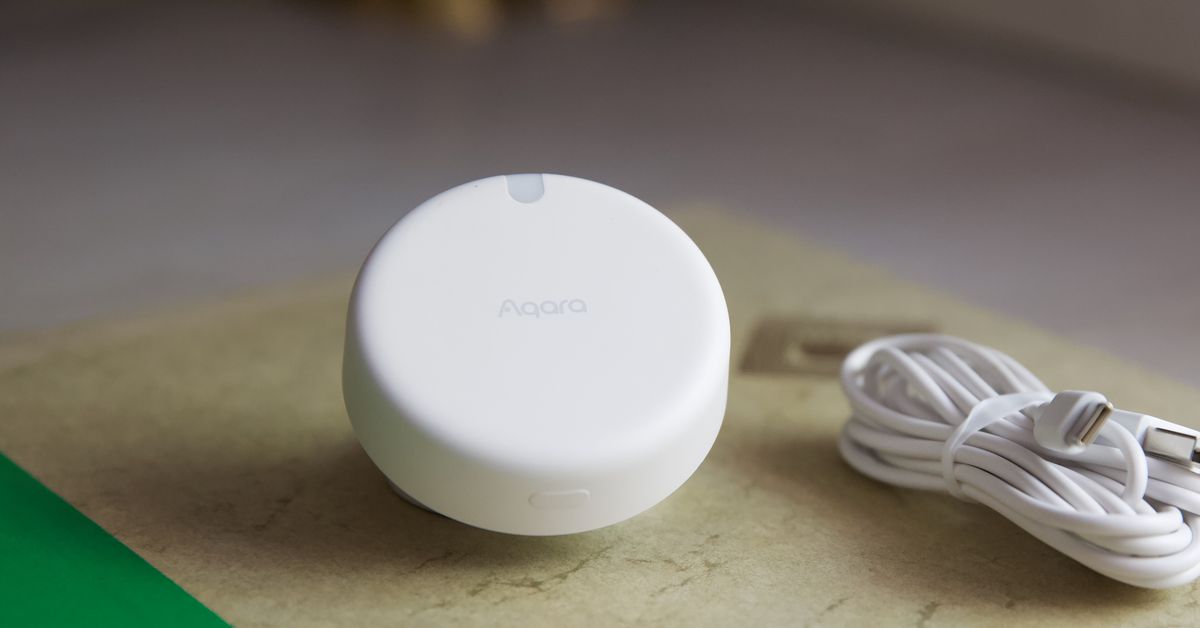
The innovative Aqara Presence Sensor FP2 that debuted at CES 2023 is getting three significant new features that could make it more useful and more effective as a smart home sensor.
Sleep Monitoring Mode, AI Person Detection, and People Counting are all coming to the Wi-Fi sensor, which is one of the first to use millimeter wave (mmWave) radar tech to accurately detect a person’s presence even when they’re sitting still, rather than relying on passive infrared motion sensing.
The small puck-shaped device can now be set to monitor and analyze “sleep status, real-time heart rate, and respiratory data,” according to a press release from the company. Sleep monitoring is available via a firmware update (V1.2.3_0002.0059) that’s rolling out globally over the next few days.
AI Person Detection and People Counting are enhancements that will arrive “in the coming months.” According to Aqara, AI Person Detection will use on-device AI to distinguish between human motion and motion caused by robot vacuums, pets, and other moving objects. People Counting will be able to send alerts when people enter a room as well as notify you how many people there are, which could be a useful security feature.
One of the big selling points of the FP2 is that, unlike traditional PIR motion sensors, mmWave radar can tell if you’re sitting, standing, or lying down and monitor motion in specific areas. This should make it possible to set up advanced automations, such as turning on a specific light when you sit down in a specific chair or opening the shades when you get out of bed in the morning.
However, I’ve been testing the device in my home for several months now, and while it works very well as a standard motion sensor, I’ve not been able to get it to respond accurately to those precise movements. Things like my ceiling fan, the many robot vacuums I test, and my three pets have often caused it to get confused. I’ll test these new features to see if they improve the device’s reliability.
The FP2 also has a fall detection mode, but it can only be in one mode at a time
The sleep monitoring function could be a very interesting upgrade for the sensor. If it works, at $83, it would be one of the least expensive options for tracking things like heart rate and breathing rate while sleeping. It’s also not something you have to wear, which can be an issue with some sleep monitoring tech, and there’s no subscription required to use it.
As a smart home sensor, it could be used as a trigger for automations in Aqara’s app based on whether you’re asleep or awake. For example. turn the lights on and open the shades if I’m awake and it’s after 6 AM, or turn the TV off if I’m asleep.
According to Aqara, Sleep Monitoring Mode requires the sensor to be installed directly above where you sleep (which could pose an installation challenge, as it’s a wired device). The FP2 also has a fall detection mode when mounted to the ceiling, and while it can only be in one mode at a time, you can switch between its functions in the app.
When in Sleep Monitoring Mode, the device can only track one person at a time, and Aqara says the accuracy of the mmWave radar “can detect the slightest movements such as the act of breathing, even under a thick blanket.” You can install more than one FP2 in the same room if you want to track you and your partner’s sleep.
Other more proven non-wearable options for sleep monitoring include the $130 Withings Sleep and the $100 second-gen Google Nest Hub, which also uses radar tech but includes a microphone to detect snoring, something the FP2 can’t do.
The FP2 works with Amazon Alexa, Google Home, and Apple Home. The company has said it will support Matter when the standard adds presence sensing.